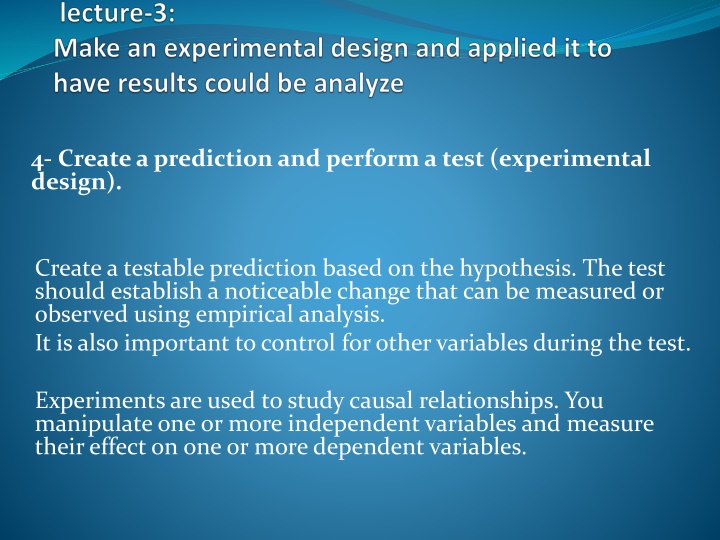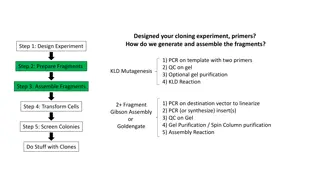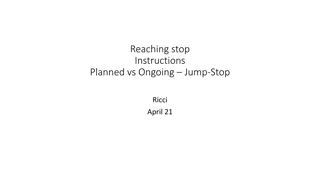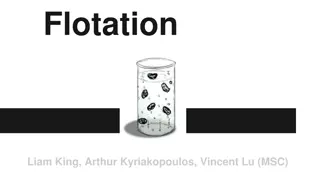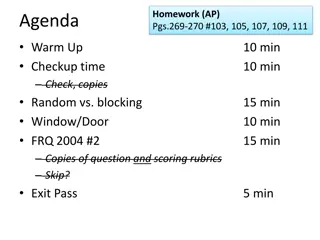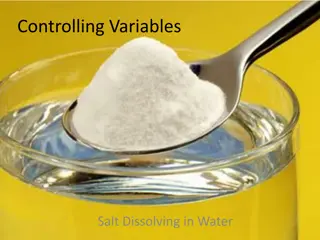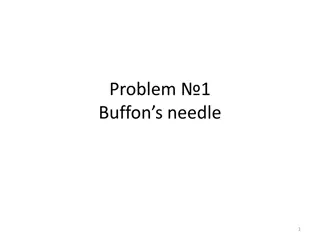Designing a Controlled Experiment: Steps and Considerations
Experimental design involves systematically testing hypotheses by manipulating independent variables and measuring their effects on dependent variables. This process includes considering variables, designing treatments, assigning subjects to groups, and planning measurements. To ensure valid conclusions, researchers must control extraneous factors and select representative samples. The steps for designing a controlled experiment involve defining variables, controlling extraneous variables, manipulating the independent variable, measuring the dependent variable, and considering the experiment's external validity.
Download Presentation

Please find below an Image/Link to download the presentation.
The content on the website is provided AS IS for your information and personal use only. It may not be sold, licensed, or shared on other websites without obtaining consent from the author.If you encounter any issues during the download, it is possible that the publisher has removed the file from their server.
You are allowed to download the files provided on this website for personal or commercial use, subject to the condition that they are used lawfully. All files are the property of their respective owners.
The content on the website is provided AS IS for your information and personal use only. It may not be sold, licensed, or shared on other websites without obtaining consent from the author.
E N D
Presentation Transcript
4- Create a prediction and perform a test (experimental design). Create a testable prediction based on the hypothesis. The test should establish a noticeable change that can be measured or observed using empirical analysis. It is also important to control for other variables during the test. Experiments are used to study causal relationships. You manipulate one or more independent variables and measure their effect on one or more dependent variables.
Experimental design Experimental design means creating a set of procedures to systematically test a hypothesis. A good experimental design requires a strong understanding of the system you are studying. There are five key steps in designing an experiment: Consider your variables and how they are related think about possible extraneous and confounding variables Design experimental treatments to manipulate your independent variable Assign subjects to groups Plan how you will measure your dependent variable 1. 2. 3. 4. 5.
Experimental design For valid conclusions, you also need to select a representative sample and control any extraneous variables that might influenceyour results. If random assignment of participants to control and treatment groups is impossible, unethical, or highly difficult, consideran observational study instead. First step, you need to define the main variables and make predictions about how they are related.
Experimental design Second step, you need to think about possible extraneous and confounding variables and consider how you might control them in your experiment. Compared to our last example, our main variables could be the Cardiac Creatine Kinase (CK-MB) and acetylcholine levels. If they high then the heart bets well be high. Then, the extraneous variables could be the dosage of hydroxychloroquine
How to design a controlled experiment. The next steps will describe how to design a controlled experiment. In a controlled experiment, you must be able to: 1. Systematically and precisely manipulate the independent variable(s). 2. Precisely measure the dependent variable(s). 3. Control any potential confounding variables. If your study system doesn t match these criteria, there are other types of research you can use to answer your research question such as observational study or statistic study.
Experimental design Third step, how you manipulate the independent variable can affect the experiment s external validity that is, the extent to which the results can be generalized and applied to the broader world. First, you may need to decide how widely to vary your independent variable. Second, you may need to choose how finely to vary your independent variable. Sometimes this choice is made for you by your experimental system, but often you will need to decide, and this will affect how much you can infer from your results. For our last example: first we have to know the dosage of hydroxychloroquine that is used in the human to calculate its dosage depending on the mice s weight.
Experimental design Fourth step, how you apply your experimental treatments to your test subjects is crucial for obtaining valid and reliable results. First, you need to consider the study size: how many individuals will be included in the experiment? In general, the more subjects you include, the greater your experiment s statistical power, which determines how much confidence you can have in your results. Then you need to randomly assign your subjects to treatment groups. Each group receives a different level of the treatment. You should also include a control group, which receives no treatment. The control group tells us what would have happened to your test subjects without any experimental intervention.
Experimental design Compared to our last example, the mice that we would use should be healthy. Next, we should make experiment design. In the papers, I read that the hydroxychloroquine used either in low dosage 400mg for five days or 800mg for 10 days. So, after calculate this dosage depend on the weight of mice, the mice could divide to three groups: 1) group one will consume the high dosage of hydroxychloroquine; 2) group two will consume the low dosage; 3) and control group will not consume hydroxychloroquine. In general, the mice number should be not less than 5 mice in every group and its better if their number more than that.
Experimental design Finally, you need to decide how you ll collect data on your dependent variable outcomes. You should aim for reliable and valid measurements that minimize research bias or error. Some variables, like CK-MD, can be objectively measured with scientific instruments. Others may need to be operationalized to turn them into measurable observations for example the gender (male or female). After that, apply the experiment design to have results.
Experimental design Analyze the results and draw a conclusion. How precisely you measure your dependent variable also affects the kinds of statistical analysis you can use on your data. Experiments are always context-dependent, and a good experimental design will take into account all of the unique considerations of your study system to produce information that is both valid and relevant to your research question. Use the metrics, figures, or tables established before the test and see if the results match the prediction. We could use many types of statistic analyzing manually or using computer programs to test if the differences between the results are significant or not and match it with our hypothesis. Then, we discuss it and make a conclusion.
Experimental design Share the conclusion or decide what question to ask next or both: Document the results of your experiment. By sharing the results with others, you also increase the total body of knowledge available. Your experiment may have also led to other questions, or if your hypothesis is disproven you may need to create a new one and test that.
